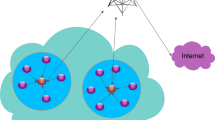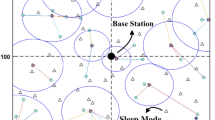Abstract
3D wireless sensor network (3D-WSN) has attracted significant interests in recent years due to its applications in various disciplinary fields such as target detection, object tracking, and security surveillance. An important problem in 3D WSN is the sensor energy optimization which determines a topology of sensors to prolong the network lifetime and energy expenditure. The existing methods for dealing with this matter namely low energy adaptive clustering hierarchy, LEACH-centralized, K-Means, single hop clustering and energy efficient protocol, hybrid-LEACH and fuzzy C-means organize the networks into clusters where non-cluster head nodes mainly carry out sensing tasks and send the information to the cluster head, while cluster head collect data from other nodes and send to the base station (BS). Although these algorithms reduce the total energy consumption of the network, they also create a large number of network disconnect which refers to the number of sensors that cannot connect to its cluster head and the number of cluster heads that cannot connect to the BS. In this paper, we propose a method based on fuzzy clustering and particle swarm optimization to handle this problem. Experimental validation on real 3D datasets indicates that the proposed method is better than the existing methods.








Similar content being viewed by others
References
Baker, C. R., et al. (2007). Wireless sensor networks for home health care. Proceedings of the 21st IEEE International Conference on Advanced Information Networking and Applications Workshops, 2, 832–837.
Roy, S., & Mukherjee, N. (2012). Topology construction of 3D wireless sensor network. In Advantages in computing and Information technology (pp. 533–542).
Heidemann, J., Stojanovic, M., & Zorzi, M. (2012). Underwater sensor networks: Applications, advances and challenges. The Royal Society, 370, 158–175.
Prasanna, S., & Rao, S. (2012). An overview of wireless sensor networks applications and security. International Journal of Soft Computing and Engineering, 2(2), 538–540.
Salahuddin, M. A. (2015). Introduction to wireless sensor networks. In Wireless sensor and mobile ad-hoc networks (pp. 3–32). New York: Springer.
Ammari, H. M., & Das, S. (2010). A study of k-coverage and measures of connectivity in 3D wireless sensor networks. IEEE Transactions on Computers, 59(2), 243–257.
Hoang, D.C., Kumar, R., & Panda, S.K. (2010). Fuzzy C-means clustering protocol for wireless sensor networks. In Proceeding of 2010 IEEE international symposium on industrial electronics (ISIE) (pp. 3477–3482).
National Instruments (2012). What is a wireless sensor network? White paper. Available at http://www.ni.com/white-paper/7142/en/
Lloyd, E. L., & Xue, G. (2007). Relay node placement in wireless sensor networks. IEEE Computer Society, 56(1), 134–138.
Logambigai, R., Thanigaivelu, K., & Murugan, K. (2012). Extending network lifetime using optimal transmission range in wireless sensor networks. In Proceedings of the International Conference on Wireless Communications, Networking and Mobile Computing (pp. 1–6).
Heinzelman, W., Chandrakasan, A., & Balakrishnan, H. (2000). Energy efficient routing protocols for wireless microsensor networks. In Proceedings of the Hawaii international conference on system sciences (pp. 1–10).
Kaur, E. S., & Gupta, E. R. (2015). Deploying an optimized LEACH-C protocol for wireless sensor network. International Journal of Advanced Research in Computer Science and Software Engineering, 5(7), 25–30.
Tan, L., Gong, Y., & Chen, G. (2008). A balanced parallel clustering protocol for wireless sensor networks using K-means techniques. In Proceeding of the second IEEE international conference on sensor technologies and applications (pp. 300–305).
Kandukuri, S., Murad, N., & Lorion, R. (2015). A single-hop clustering and energy efficient protocol for wireless sensor networks. In Proceeding of the 2015 IEEE conference on radio and antenna days of the Indian Ocean (pp. 1–2).
Razaque, A., Mudigulam, S., Gavini, K., Amsaad, F., Abdulgader, M., & Krishna, G. S. (2016). H-LEACH: Hybrid-low energy adaptive clustering hierarchy for wireless sensor networks. In Proceeding of the 2016 IEEE long Island systems, applications and technology conference (pp. 1–4).
Lee, J. S., & Cheng, W. L. (2012). Fuzzy-logic-based clustering approach for wireless sensor networks using energy predication. IEEE Sensors Journal, 12(9), 2891–2897.
Das, S. K., Tripathi, S., Burnwal, A. P. (2015). Fuzzy based energy efficient multicast routing for ad-hoc network Communication, Control and Information Technology: Computer (pp. 348–355).
Das, S. K., Kumar, A., Das, B., & Burnwal, A. P. (2013). Ethics of reducing power consumption in wireless sensor networks using soft computing techniques. International Journal of Advanced Computer Research, 3, 301–304.
Shang, Y. (1997). Global search methods for solving nonlinear optimization problems. Ph.D. thesis, University of Illinois at Urbana-Champaign.
Kennedy, J., & Eberhart, R. (1995). Particle swarm optimization. Proceedings of IEEE International Conference on Neural Networks, 4, 1942–1948.
Geetha, V., Kallapur, P. V., & Tellajeerac, S. (2012). Clustering in wireless sensor networks: Performance comparison of LEACH & LEACH-C protocols using NS2. International Conference on Computer, Communication, Control and Information Technology, 4, 163–170.
Tam, N.T., Hai, D.T., Son, L.H., & Vinh, L.T. (2015). Optimization for the sensor placement problem in 3D environments. In Proceeding of the 12th IEEE international conference on networking, sensing and control (ICNSC15) (pp. 327 333).
Baghouri, M., Hajraoui, A., & Chakkor, S. (2015). Low energy adaptive clustering hierarchy for three-dimensional wireless sensor network. Recent Advances in Communications, 214–218. http://www.inase.org/library/2015/zakynthos/bypaper/COMMUN/COMMUN-32.pdf.
Wah, B. W., Wang, T., Shang, Y., & Wu, Z. (2000). Improving the performance of weighted Lagrange-multiplier methods for nonlinear constrained optimization. Information Science, 124, 241–272.
Hai, D. T., Tam, N. T., Son, L. H., & Vinh, L. T. (2016). Experimental analyses of Terrain factors to performance of sensor placement optimization in 3D environments. International Journal of Engineering and Technology, 8(6), 394–400.
Author information
Authors and Affiliations
Corresponding author
Appendix
Appendix
Source codes and datasets of this research are available at: https://sourceforge.net/projects/fcm-pso/files/?source=navbar
Rights and permissions
About this article
Cite this article
Tam, N.T., Hai, D.T., Son, L.H. et al. Improving lifetime and network connections of 3D wireless sensor networks based on fuzzy clustering and particle swarm optimization. Wireless Netw 24, 1477–1490 (2018). https://doi.org/10.1007/s11276-016-1412-y
Published:
Issue Date:
DOI: https://doi.org/10.1007/s11276-016-1412-y




